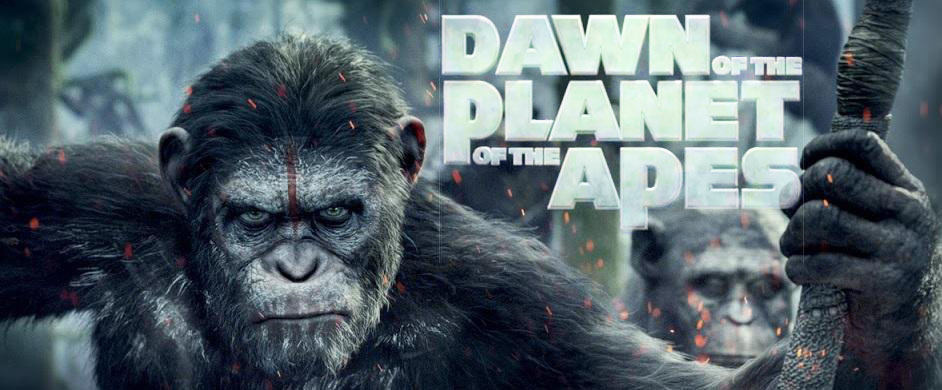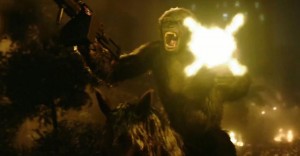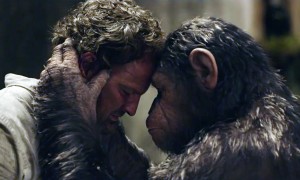 DAWN OF THE PLANET OF THE APES appeared in theaters recently and the odds were against it. More generally, the summer months have seen poor box office returns and DAWN might have continued in this vein. Specifically, the second installment in the PLANET OF THE APES series had to demonstrate that lightning could strike twice as 20th Century Fox built on the success of the previous RISE OF THE PLANET OF THE APES. Given these challenges this reviewer was skeptical, but doubts were unmerited as DAWN OF THE PLANET OF THE APES is a great film, justifying the $73 million it took in box office receipts over the opening weekend, and keeping the rebooted Apes franchise alive.
DAWN OF THE PLANET OF THE APES appeared in theaters recently and the odds were against it. More generally, the summer months have seen poor box office returns and DAWN might have continued in this vein. Specifically, the second installment in the PLANET OF THE APES series had to demonstrate that lightning could strike twice as 20th Century Fox built on the success of the previous RISE OF THE PLANET OF THE APES. Given these challenges this reviewer was skeptical, but doubts were unmerited as DAWN OF THE PLANET OF THE APES is a great film, justifying the $73 million it took in box office receipts over the opening weekend, and keeping the rebooted Apes franchise alive.
Summary
The conclusion of RISE OF THE PLANET OF THE APES saw the development of fatal side effects in humans through the virus that was part of ALZ-112, a drug created by Gen-Sys for the treatment of various neurological disorders. DAWN OF THE PLANET OF THE APES takes place ten years after the conclusion of RISE, and a montage of news footage sets the stage for this time period as it tells of the results of a worldwide simian flu pandemic that has destroyed most human life on earth.
While humanity fought for its life, the small group of intelligent apes under the leadership of Caesar (played in motion capture by Andy Serkis) multiplied, and created their own tribal civilization. Caesar has a family, including a wife, a young adult son and a newborn son. Together the apes have manufactured hut-like shelter, organized hunts, domesticated horses, and communicate in a form of sign language and limited speech. But they wonder after ten winters whether all of humanity is truly gone.
While walking through the forest two young adult apes come into contact with a small group of humans. One human panics and shoots one of the apes, but not fatally. After hearing the shot, the woods are quickly filled with hundreds of apes, which surround the small group of humans. Caesar sends then on their way, but they are followed so that the apes may know more about the potential threat. Paralleling the ape civilization, a large number of humans have survived, immune to the simian flu, and they are carving out an existence in the city of San Francisco. But they are running out of fuel, and they live with the mounting fear that the violence that came with the lawlessness during the initial flu outbreak will return once again. In order to avoid this scenario, Malcolm (played by Jason Clarke), along with his son Alexander (Kodi Smit-McPhee) and girlfriend (Keri Russell), volunteer to return to the forest in ape territory in the hopes of convincing them to allow them to restore electricity by repairing a dilapidated dam.
Malcom is able to convince a reluctant Caesar to move forward with work on the dam, but some of Caesar’s community are suspicious of the humans, particularly Koba, an ape with a history of abuse in the past at the hands of his human captors. Some in the human camp are suspicious as well giving the simian flu pandemic and its connection to the apes, particularly Dreyfuss (Gary Oldman), who co-founded the human group with Malcom. This sets the stage for an uneasy co-existence between apes and humans, with some in both camps desiring peace, while others yearn for violence and war. Those wanting violence create the conditions that bring it about, and Caesar must fight Koba for leadership of the apes and the direction the simian civilization will take for the future in an ape and human world.
Analysis
For any number of reasons DAWN OF THE PLANET OF THE APES could have been a failure. In order to be successful it had to be at least as good as its predecessor RISE, it had to navigate a change in directors from the first film, and it had to present a compelling storyline that kept the rebooted version moving along its own trajectory while still being respectful of the Apes mythology from previous films. There was also the possibility that as the number of apes increased and ran across the screen as an army, at times on horseback firing automatic weapons, that good storytelling would get lost in a big budget, action sequences, and visual effects. Thankfully the various challenges faced by the creators of DAWN were met successfully and with satisfying results.
In terms of its visuals, DAWN is impressive. Unlike RISE, which for the most part takes place in various indoor locations until the climax, DAWN is largely set in the woods of the San Francisco Bay Area. This put new pressures on WETA Studios and their motion capture technology, which designed new equipment that would not only be able to record the movements and facial expressions of the actors playing apes, but also horses, and the forest landscapes that made up the ape territory. The result is impressive, as the computer-generated apes and other special effects are extremely detailed and realistic, aiding in the suspension of disbelief and facilitating the plausibility of the story, just as John Chambers’ makeup did for the original films of the franchise in the 1960s and 1970s.
 In terms of narrative, while DAWN incorporates action sequences, these do not overshadow good and serious storytelling. This film draws upon an element in one of the original five films in the franchise, BATTLE FOR THE PLANET OF THE APES, in addition to many parallel elements it incorporates from the film. In BATTLE, a small group of humans live almost as slaves for the apes, and are responsible for doing various things for ape civilization, including teaching literacy. During one of the educational sessions, a human teacher imparts one of the most important ethical teachings from the ape Lawgiver’s Sacred Scrolls: “Ape shall never kill ape.” This is featured in DAWN early on as the audience sees it scrawled on the walls of the apes’ village, perhaps a teaching area led by Maurice the orangutan. This then serves as the major ethical thread for the film, not only for ape civilization, but for human as well, as both wrestle with conflicting desires in their midst, some with distrust fueling desires for violence and war, and others willing to extend trust in hope supporting desires for co-existence and peace.
In terms of narrative, while DAWN incorporates action sequences, these do not overshadow good and serious storytelling. This film draws upon an element in one of the original five films in the franchise, BATTLE FOR THE PLANET OF THE APES, in addition to many parallel elements it incorporates from the film. In BATTLE, a small group of humans live almost as slaves for the apes, and are responsible for doing various things for ape civilization, including teaching literacy. During one of the educational sessions, a human teacher imparts one of the most important ethical teachings from the ape Lawgiver’s Sacred Scrolls: “Ape shall never kill ape.” This is featured in DAWN early on as the audience sees it scrawled on the walls of the apes’ village, perhaps a teaching area led by Maurice the orangutan. This then serves as the major ethical thread for the film, not only for ape civilization, but for human as well, as both wrestle with conflicting desires in their midst, some with distrust fueling desires for violence and war, and others willing to extend trust in hope supporting desires for co-existence and peace.
DAWN director, Matt Reeves, has said in interviews that there is no overt attempts at engaging in social commentary through this film, a facet found in some of the first films in the original five of the franchise, and somewhat in RISE. Even so, filmmakers are embedded in their social and cultural contexts, and this can’t help but connect to the works they create. While some have speculated that DAWN incorporates an anti-gun message, a more probable interpretation is one opposed to human violence which guns symbolize. Not only does DAWN reflect the constant human struggle with the tendencies toward dehumanizing “the other” and seeing them as universally evil thus justifying acts of violence and war, more specific application can be made to current events in the Middle East. As this review is written, the nation of Israel continues to engage in military actions and the bombardment of Palestinians in Gaza in response to Palestinian missile firings into Israel and the kidnapping and execution of three Israeli youth. At the time of writing, the death toll among the Palestinians is now over 200, many civilians, while Israeli casualties are presently less than twenty. There is a long and unfortunate tendency in this region for Israelis and Palestinians to view each other as sub-human, as animals, and for the voices of those who cry out with distrust and calls for violence to find success as they mobilize others to realize these desires.
 In DAWN, Caesar and Malcolm pursued a path of co-existence, live and let live. But in the end this was not enough. A more fruitful path would have been for them to move beyond the low bar of tolerance and co-existence, seeking instead peaceful tension over irreconcilable differences as relationships transform enemies into trusted rivals. Perhaps a similar pathway is needed in the Middle East and elsewhere. DAWN reminds us in a world ruled by humans that we have not come very far from our animal past, and that we must constantly battle the desires of our inner beast that wishes to destroy outsiders (sometimes insiders when they challenge our authority and agenda too).
In DAWN, Caesar and Malcolm pursued a path of co-existence, live and let live. But in the end this was not enough. A more fruitful path would have been for them to move beyond the low bar of tolerance and co-existence, seeking instead peaceful tension over irreconcilable differences as relationships transform enemies into trusted rivals. Perhaps a similar pathway is needed in the Middle East and elsewhere. DAWN reminds us in a world ruled by humans that we have not come very far from our animal past, and that we must constantly battle the desires of our inner beast that wishes to destroy outsiders (sometimes insiders when they challenge our authority and agenda too).
Conclusion
Plans are already underway for the next film to follow DAWN. Matt Reeves has agreed to direct, and he will write co-author the script. This is a good thing because we continue to be fascinated with these apes and their ability to help us reflect on ourselves through good science fiction storytelling.





There are no responses yet